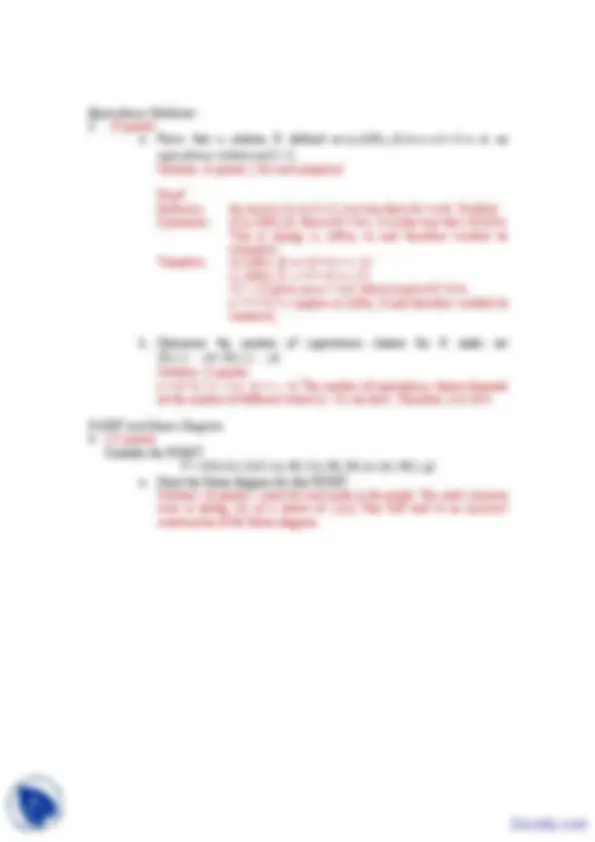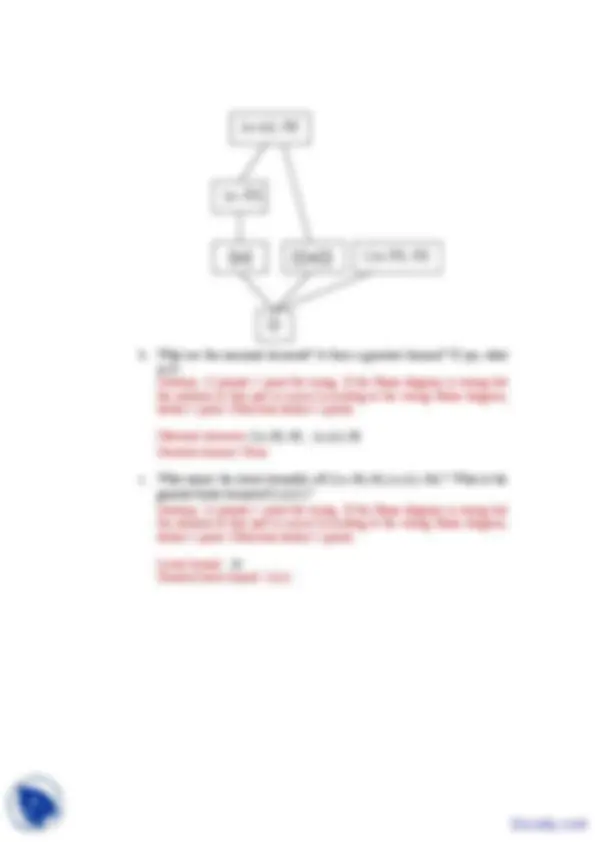




Study with the several resources on Docsity

Earn points by helping other students or get them with a premium plan


Prepare for your exams
Study with the several resources on Docsity

Earn points to download
Earn points by helping other students or get them with a premium plan
Community
Ask the community for help and clear up your study doubts
Discover the best universities in your country according to Docsity users
Free resources
Download our free guides on studying techniques, anxiety management strategies, and thesis advice from Docsity tutors
During the study of discrete mathematics, I found this course very informative and applicable.The main points in these lecture slides are:Relation Basics, Reflexivity, Symmetry, Transitivity of Following Relations, Transitive Closure, Intersection of Two Relations, Equivalence Relation, Number of Equivalence Classes, Poset and Hasse Diagram
Typology: Slides
1 / 4

This page cannot be seen from the preview
Don't miss anything!



Relation Basics
b. R = {(0,1), (1, 0), (2, 4), (4, 2), (4, 6), (6, 4)}on set S ={0,1, 2, 4, 6} i. Determine its reflexivity, symmetry, and transitivity ii. What is its transitive closure? Solution: (5 points. 3 for part i and 2 for part ii) i. Symmetric ii. {(0,1), (1, 0), (2, 4), (4, 2), (4, 6), (6, 4), (0, 0), (1, 1), (2, 2), (4, 4), (6, 6), (2, 6), (6, 2)}
c. xRy ↔ x − y is a multiple of 3 on set S = ] Solution: (3 points) No partial credit. Reflexive, symmetric, transitive.
d. xRy ↔| x | |≠ y |on set S ={1, 2,3, 4,5, 6, 7,8,9} Solution: (3 points) No partial credit. Symmetric
e. ( x 1 (^) , y 1 (^) ) R x ( 2 (^) , y 2 (^) ) ↔ x 1 (^) ≤ x 2 (^) , y 1 (^) ≥ y 2 on set S = × Solution: (3 points) No partial credit. Reflexive, transitive.
4 points: Correct answer and a sound reasoning.
Both are reflexive. According to the definition of reflexivity, (s1, s1), (s2, s2), …, (sN, sN) are all in R1 and R2. Therefore, no matter it is a union of an intersection of two relations, (s1, s1), (s2, s2), ..., (sN, sN) are all in the resulting relation, too.
b. If R 1 and R 2 are transitive, is R 1 (^) ∩ R 2 transitive? Is R 1 (^) ∪ R 2 transitive? Explain
your answer. Solution: (4 points, union and intersection are each 2 points). 1 point: Both answers are wrong or both without explanations. 2 points: Correct answers, flawed reasoning, etc. 3 points: Minor errors. 4 points: Correct answer and a sound reasoning.
Union is not necessarily transitive. Counterexample: R1 = {(a, b), (b, c), (a, c)}, R2 = {(b, c), (c, a), (b, a)} R1 U R2 = {(a, b), (b, c), (a, c), (c, a), (b, a)} The union is not transitive, because (a, c) and (c, a) implies (a, a). But (a, a) is not in the set. Intersection is transitive. If the cardinality is less than 2, done. Else, if (a, b) and (b, c) are in R 1 (^) ∩ R 2 , it implies (a, b) and (b, c) are in R and (a, b), (b, c) are in R2, too. This implies (a, c) is in R1 and (a, c) in R2, too. This is saying (a, c) is in the intersection of R1 and R2, namely, R 1 (^) ∩ R 2. This proves R 1 (^) ∩ R 2 is transitive.
c. Can R 1 be symmetric and antisymmetric at the same time? Why or why
not? Solution: (3 points). An answer without an explanation/ example or a wrong answer: 1 point. Minor errors: 2 points Correct answer and a valid example: 3 points
Yes. Example: {(1, 1), (2, 2)} on {1, 2}
d. Can R 1 be neither symmetric nor antisymmetric? Why or why not?
Solution: (3 points). An answer without an example or a wrong answer: 1 point. Minor errors: 2 points Correct answer and a valid example: 3 points
Yes. Example: {(1, 2), (2, 1), (2, 3)} on {1, 2, 3}
b. What are the maximal elements? Is there a greatest element? If yes, what is it? Solution: (3 points) 1 point for trying. If the Hasse diagram is wrong but the solution to this part is correct according to the wrong Hasse diagram, deduct 1 point. Otherwise deduct 2 points.
Maximal elements: {{ , a ∅}, ∅} , { ,{ }, a a ∅} Greatest element: None
c. What is(are) the lower bound(s) of {{{ , a ∅}, ∅},{ ,{ }, a a ∅}}? What is the
greatest lower bound of{{{ }}} a? Solution: (3 points) 1 point for trying. If the Hasse diagram is wrong but the solution to this part is correct according to the wrong Hasse diagram, deduct 1 point. Otherwise deduct 2 points.
Lower bound: ∅ Greatest lower bound: {{a}}